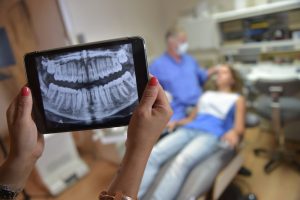 Prior to dental implant surgery, digital treatment planning ensures that your dentist can achieve optimal results with precise implant placement. Intraoral scanners and CBCT scans assist in treatment planning by providing detailed images of a patient’s mouth. Because the dentist will need to place the implants in the strongest part of the jawbone, the images produced from the scans will help him or her determine that location.
Prior to dental implant surgery, digital treatment planning ensures that your dentist can achieve optimal results with precise implant placement. Intraoral scanners and CBCT scans assist in treatment planning by providing detailed images of a patient’s mouth. Because the dentist will need to place the implants in the strongest part of the jawbone, the images produced from the scans will help him or her determine that location.
At Fresno Dental Scan, we provide imaging services crucial to dental implant surgery. Call (559) 297-6823 to schedule an appointment at our Fresno, CA location.
What is an Intraoral Scanner?
An intraoral scanner works like a camera to take images of your teeth. During an imaging session, the dentist will use an intraoral scanner to produce models of teeth that eliminate the need for conventional impressions. With an intraoral scanner, dentists and patients have access to digital records of teeth images, making it easy to transfer or share files when needed.
What Is a CBCT Scan?
Like an x-ray machine, a dental cone beam computed tomography (CBCT) scan takes three-dimensional images of your teeth, soft tissues (gums and soft palate), nerve pathways, and bone (jaw and teeth). The shape of the beam, a cone, differs from a traditional x-ray and allows for better capture of details of the mouth systems.
The machine itself is one in which the patient will sit or lie down, and the scanner will rotate around the patient’s head. As with all x-ray machines, the patient experiences some exposure to radiation. Pregnant women and young children should avoid any radiation exposure unless absolutely necessary.
What Information Is Obtained from a CBCT Scan?
CBCT scans provide information about the jawbone and the teeth critical to an implant surgery and unavailable from a regular x-ray. This information includes bone loss, density, and other difficult-to-discover details. Regular x-rays cannot provide enough detail to indicate whether a patient’s jawbone is strong enough to receive an implant. In addition to the location of implant placement, the angle at which an implant is placed also affects procedure outcome.
Examining the gums and nerve pathways becomes possible with a CBCT scan. Soft tissue damage from gum disease will indicate whether you will need to regain gum health before undergoing implant surgery to decrease risk of infection and improve healing time.
How Does the Dentist Use Intraoral Scanner and CBCT Scan Results?
CBCT scan results give the dentist information that he or she will use in multiple ways. The details from a CBCT scan about your mouth health and the systems help determine treatment planning steps, such as whether you might need bone grafting. Combined with imaging from an intraoral scanner, the details from a CBCT scan assist in fabricating a surgical guide using stereolithography, a process in which a three-dimensional mold is created to guide implant surgery jawbone drilling and implant placement. The model contains spaces for drill-guiding, used to create the holes in the jawbone in which implants will go.
Proper planning for the dental implant procedure prepares the dentist to complete the surgery and reassures you as the patient that all steps are carefully measured and conducted. At Fresno Dental Scan, we use state-of-the-art technology for our imaging services and understand the necessity of digital treatment planning. Schedule an appointment or learn more about CBCT technology and dental implants by calling us at (559) 297-6823.